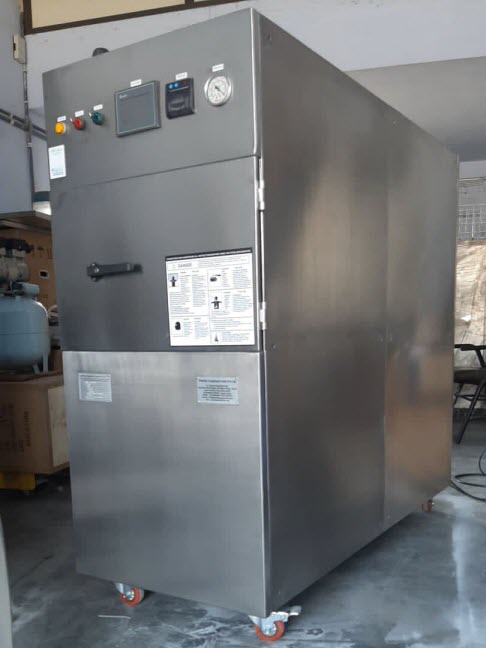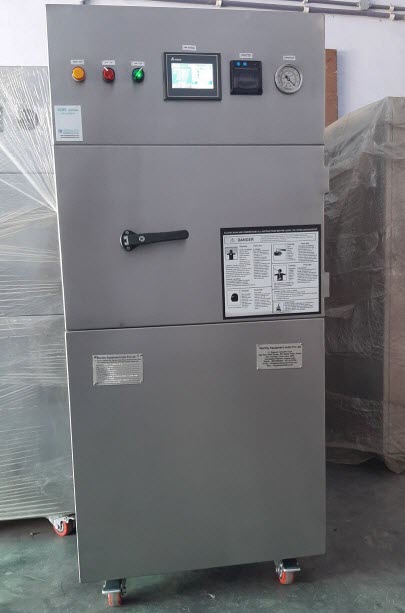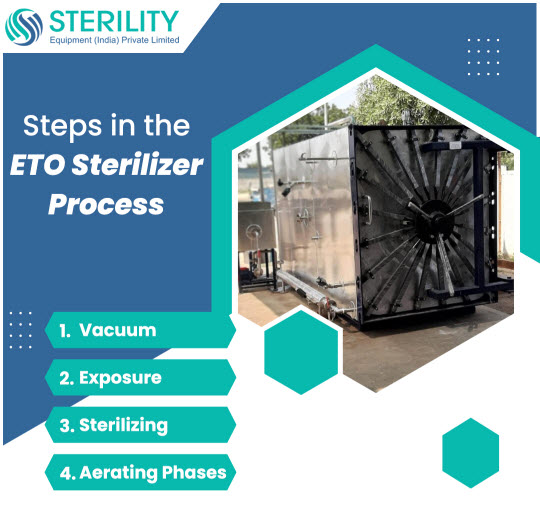ETO Sterilization Validation
Ethylene Oxide (ETO) sterilization validation plays a vital role in ensuring the efficacy and safety of the sterilization process. In this section, we will provide an overview of ETO sterilization validation, emphasizing its importance and relevance.
Importance of ETO Sterilization Validation: ETO sterilization is widely used for the sterilization of medical devices, pharmaceuticals, and other sensitive items due to its ability to penetrate complex materials and effectively eliminate microorganisms. However, the validation of ETO sterilization methods is essential to ensure that the sterilization process consistently achieves the desired level of microbial reduction.
Understanding ETO Sterilization
In this section, we will delve deeper into the ETO sterilization process. We will explain how ETO sterilization works, the components of a sterilization cycle, and the interaction between ETO and microorganisms. By understanding the fundamental principles of ETO sterilization, we can better comprehend the validation techniques and considerations discussed later in the article.
ETO Sterilization Cycle Parameters
To achieve effective sterilization during an ETO (Ethylene Oxide) sterilization cycle, certain critical parameters must be carefully considered. These parameters include the optimal temperature, humidity, and exposure time, which play crucial roles in ensuring the efficacy and safety of the sterilization process.
Temperature:
The temperature within the sterilization chamber is a vital parameter that significantly impacts the effectiveness of ETO sterilization. Generally, temperatures ranging between 37°C to 63°C (99°F to 145°F) are recommended for optimal sterilization results. It is crucial to maintain a consistent and controlled temperature throughout the entire sterilization cycle.
Humidity:
Adequate humidity levels are essential to facilitate the penetration of ETO gas and enhance its sterilizing effect. Typically, humidity levels between 30% to 80% relative humidity (RH) are maintained during the ETO sterilization process. Proper humidification ensures the uniform distribution of ETO gas and helps to prevent the formation of condensation, which can affect the sterilization efficacy.
Exposure Time:
The exposure time refers to the duration during which the items to be sterilized are exposed to the ETO gas. This parameter is critical in ensuring sufficient contact time for the gas to penetrate and eliminate microorganisms effectively. Exposure times for ETO sterilization typically range from several hours to a few days, depending on the complexity and nature of the items being sterilized.
By carefully monitoring and controlling these critical parameters, organizations can optimize the ETO sterilization cycle for maximum efficacy and safety. Regular validation and calibration of the sterilization equipment are essential to ensure consistent and reliable performance. Additionally, it is important to comply with regulatory guidelines and industry standards to maintain quality and safety in the sterilization process.

ETO Sterilization Equipment and Safety Precautions
When it comes to ETO (Ethylene Oxide) sterilization, using the right equipment and implementing necessary safety precautions are paramount to protect both individuals involved in the process and the integrity of the sterilization procedure. Let’s delve into the importance of appropriate sterilization equipment and the essential safety measures to be followed.
Sterilization Equipment:
To achieve successful ETO sterilization, specialized equipment designed specifically for this method is required. This includes a sterilization chamber or cabinet that can maintain the required temperature, humidity, and gas concentration levels throughout the sterilization cycle. The chamber should have proper seals to prevent gas leakage and allow efficient gas circulation. Additionally, gas injectors and exhaust systems play a crucial role in controlling the gas flow and removing residual ETO after the cycle.
Personal Protective Equipment (PPE):
The safety of personnel involved in the ETO sterilization process is of utmost importance. Proper usage of personal protective equipment (PPE) is essential to minimize exposure to ETO gas and protect against potential health risks. The recommended PPE may include gloves, goggles or face shields, protective clothing, and respiratory protection devices such as masks or respirators. The type of PPE required may vary depending on the specific work environment and the level of exposure to ETO.
Ventilation Systems:
Adequate ventilation systems are necessary to maintain a safe environment during ETO sterilization. Effective ventilation helps in removing ETO gas from the working area, reducing the risk of gas accumulation. Properly designed exhaust systems, ventilation hoods, or local exhaust ventilation can efficiently remove ETO gas, ensuring the safety of personnel and preventing any potential hazardous build-up.
Monitoring and Alarms:
Continuous monitoring of ETO levels within the sterilization facility is crucial for early detection of any gas leaks or abnormal concentrations. Installing gas detection systems and alarms can promptly alert personnel to potential risks, allowing immediate action to be taken to mitigate hazards. Regular calibration and maintenance of gas monitoring equipment are essential to ensure accurate and reliable performance.
Training and Standard Operating Procedures (SOPs):
Comprehensive training programs and clear Standard Operating Procedures (SOPs) should be implemented to educate personnel on the safe handling of ETO sterilization equipment and the proper use of PPE. Training should cover aspects such as equipment operation, emergency response procedures, and the handling and storage of ETO cylinders.
By emphasizing the use of appropriate sterilization equipment, implementing safety precautions, and providing adequate training to personnel, organizations can ensure the safety of individuals involved in ETO sterilization. Compliance with regulatory guidelines and industry best practices is crucial to maintain a safe working environment and minimize risks associated with ETO exposure.
Techniques for ETO Sterilization Validation
Validating the effectiveness of ETO (Ethylene Oxide) sterilization is crucial to ensure the safety and efficacy of the sterilization process. In this section, we will delve into two commonly employed techniques for ETO sterilization validation:
the half-cycle method and the overkill method. By understanding these techniques, their advantages, limitations, and key considerations, we can establish robust validation procedures.

Half-Cycle Method for ETO Sterilization Validation
In this subsection, we will explore the half-cycle method for ETO (Ethylene Oxide) sterilization validation. We will explain the concept behind this method, its application, the use of biological indicators (BIs), data analysis, and result interpretation.
Concept of the Half-Cycle Method: The half-cycle method involves exposing biological indicators (BIs) to half of the standard ETO sterilization cycle. This method relies on the assumption of linear microbial kill kinetics, where sterilization efficacy increases proportionally with time. By evaluating BIs exposed to half the cycle, it is inferred that the remaining half will achieve the desired microbial reduction.
Application of the Half-Cycle Method: The half-cycle method is applied by placing BIs, containing highly resistant microorganisms, within the sterilization load. These BIs represent the hardest-to-kill microorganisms in the load. The load is then exposed to ETO gas for half of the standard sterilization cycle duration.
Use of Biological Indicators (BIs): Biological indicators serve as indicators of sterilization efficacy. BIs are designed to mimic the resistance of the most challenging microorganisms present in the load. After exposure to ETO gas, BIs are assessed for microbial growth or survival. Absence of growth or survival indicates successful sterilization.
Data Analysis and Result Interpretation: Data analysis involves examining the results obtained from the BIs exposed to the half-cycle method. If no microbial growth or survival is observed in the BIs, it indicates the sterilization process effectively eliminated microorganisms. However, if growth or survival is detected, it suggests the need for adjustments in cycle parameters or process improvements.
Interpreting the results obtained through the half-cycle method requires careful consideration. It is essential to evaluate the statistical significance of the results, considering factors such as the number and distribution of BIs used. Comparing the results against predetermined acceptance criteria helps determine the success or failure of the sterilization process.
The half-cycle method offers time-efficient validation as it requires half the duration of a full cycle. It enables rapid assessment of sterilization efficacy and is suitable for routine monitoring and process control. However, it is important to note the limitations of this method, such as the assumptions of linear kill kinetics and the need for careful BI placement.
By implementing the half-cycle method for ETO sterilization validation and analyzing the obtained results effectively, organizations can ensure the efficacy and reliability of their sterilization processes.
The half-cycle method is a widely used technique for ETO sterilization validation. It involves exposing biological indicators (BI) to half of the standard sterilization cycle. The BI, typically containing highly resistant microorganisms, is strategically placed within the sterilization load. After exposure, the BI is evaluated for microbial growth or survival.
Advantages:
- Time-efficient validation method as it requires half the duration of a full cycle.
- Allows rapid assessment of sterilization efficacy.
- Useful for routine monitoring and process control.
Limitations:
- May not capture the worst-case scenarios encountered during a full cycle.
- Relies on assumptions of linear microbial kill kinetics during the sterilization process.
- Requires careful placement of the BI to ensure representative results.
Key Considerations:
- Selection of appropriate BI that represents the hardest-to-kill microorganisms.
- Correct placement of BI within the load to ensure proper assessment.
- Adequate BI quantity and distribution to ensure statistical significance.
- Proper data analysis and interpretation to determine sterilization efficacy.
Overkill Method for ETO Sterilization Validation
In this subsection, we will explore the overkill method, another commonly used technique for ETO (Ethylene Oxide) sterilization validation. We will explain how the overkill method works, including the determination of the validation dose, the evaluation using heat-resistant biological indicators (BIs), the significance of worst-case scenarios, and the interpretation of overkill results.
Working Principle of the Overkill Method: The overkill method is based on the principle of subjecting the sterilization load to a significantly higher dose of ETO than required for routine sterilization. This method provides an extra margin of safety and validation assurance by employing a dose that surpasses the anticipated microbial challenge.
Determining the Validation Dose: To determine the validation dose, various factors are considered, including the type of load, worst-case scenarios, and industry guidelines. The validation dose is typically calculated as a logarithmic reduction (e.g., 12 log reduction) from the anticipated microbial load. This dose ensures a sufficient margin of safety to achieve sterilization efficacy even under challenging conditions.
Evaluation Using Heat-Resistant Biological Indicators (BIs): Heat-resistant biological indicators (BIs) are used in the overkill method to evaluate the sterilization process. These BIs contain highly resistant microorganisms that mimic the hardest-to-kill microorganisms present in the load. BIs are strategically placed within the load, and their survival or growth is assessed after exposure to the overkill dose of ETO.
Significance of Worst-Case Scenarios: The overkill method is particularly significant for assessing worst-case scenarios in ETO sterilization. By subjecting the load to a higher dose, the overkill method accounts for potential variations in the load composition, packaging, or challenging environmental conditions. This approach ensures that even under unfavorable circumstances, the sterilization process maintains its effectiveness.
Interpretation of Overkill Results: Interpreting the results obtained through the overkill method requires careful analysis. If no microbial growth or survival is observed in the BIs, it indicates successful sterilization, validating the process’s efficacy. However, if growth or survival is detected, it suggests the need for adjustments in the sterilization parameters or process improvements to achieve the desired level of microbial reduction.
The overkill method provides a conservative approach to ETO sterilization validation, offering a broader range of coverage for potential sterilization challenges. It ensures the validation of worst-case scenarios and complex loads, providing an extra level of assurance in the sterilization process.
By employing the overkill method, determining the appropriate validation dose, evaluating with heat-resistant BIs, considering worst-case scenarios, and interpreting the obtained results, organizations can validate the effectiveness and reliability of their ETO sterilization processes.
The overkill method is another commonly employed technique for ETO sterilization validation. It involves subjecting the load to a sterilization cycle with a significantly higher dose of ETO than required for routine sterilization. Biological indicators (BI) containing resistant microorganisms are placed within the load. The BI is evaluated for microbial growth or survival after exposure to assess the effectiveness of the sterilization process.
Advantages:
- Provides a conservative approach by employing a higher ETO dose.
- Covers a broader range of potential sterilization challenges.
- Suitable for validating worst-case scenarios and complex loads.
Limitations:
- Requires higher ETO doses, which can be impractical for routine sterilization.
- Longer validation cycle time due to the higher ETO dose requirement.
- Relatively more resource-intensive in terms of BI selection and evaluation.
Key Considerations:
- Selection of appropriate BI that represents the hardest-to-kill microorganisms.
- Determination of the appropriate overkill factor (e.g., 12 log reduction) based on industry guidelines.
- Adequate aeration and residual ETO removal to ensure safety post-validation.
- Proper data analysis and interpretation to validate sterilization efficacy.
By utilizing the half-cycle method and the overkill method for ETO sterilization validation, organizations can ensure the effectiveness of their sterilization processes. Careful consideration of the advantages, limitations, and key considerations associated with each method allows for robust validation and reliable sterilization outcomes.

Considerations for ETO Sterilization Validation
During ETO (Ethylene Oxide) sterilization validation, several crucial considerations must be taken into account to ensure the effectiveness and safety of the process. In this section, we will cover these important considerations, including product compatibility, process monitoring, routine testing, and ongoing validation.
Product Compatibility with ETO Sterilization:
One key consideration is ensuring the compatibility of products with ETO sterilization. Different materials and packaging may have varying susceptibilities to ETO, and not all products can withstand the sterilization process without adverse effects. It is essential to assess the compatibility of materials, including plastics, metals, elastomers, and packaging components, to ensure their integrity and functionality are not compromised during sterilization.
Process Monitoring and Control:
Effective process monitoring and control are vital during ETO sterilization. Continuous monitoring of critical parameters such as temperature, humidity, gas concentration, and exposure time ensures that the sterilization cycle operates within the specified parameters. Regular calibration and maintenance of sterilization equipment, including sensors and controllers, are necessary to ensure accurate and reliable monitoring.
Routine Testing and Challenge Studies:
Routine testing and challenge studies are essential components of ETO sterilization validation. Regularly performing microbial testing on the sterilized products helps assess the effectiveness of the sterilization process. Challenge studies, which involve intentionally contaminating items with known microorganisms, can simulate worst-case scenarios and provide additional validation of the sterilization process under challenging conditions.
Ongoing Validation and Revalidation:
ETO sterilization validation should be an ongoing process to ensure the continued efficacy of the sterilization process. Periodic revalidation is necessary to account for changes in equipment, materials, or processes that may impact sterilization efficacy. Revalidation should also be performed following any significant changes, such as equipment upgrades, process modifications, or product design alterations.
Regulatory Compliance and Standards:
Compliance with regulatory requirements and adherence to industry standards are crucial considerations in ETO sterilization validation. Organizations must stay updated with applicable regulations, guidelines, and standards, such as those set by regulatory authorities and organizations like ISO (International Organization for Standardization) and AAMI (Association for the Advancement of Medical Instrumentation).
By considering product compatibility, implementing robust process monitoring, conducting routine testing and challenge studies, and maintaining ongoing validation, organizations can ensure the effectiveness and safety of their ETO sterilization processes. Adhering to regulatory compliance and industry standards further enhances the quality and reliability of the sterilization procedures.





